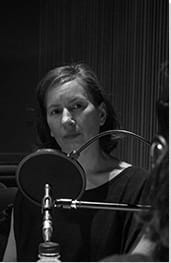Summary of Andrea Fraser
A pioneering Feminist and institutional critique artist, Andrea Fraser strikes at the heart of the art world system. She has explored (and critiqued) topics ranging from the rhetoric of cultural value upheld by museum institutions, the role of the artist as a purveyor of goods and services in the commodified art world, to the cultural sector's complicity with racism and structural inequality. In her work, there's a rare and often vulnerable self-reflexivity regarding her own role in the art world. Her practice invites affective identification and empathy on the part of the viewer in ways that exceed previous parameters of institutional critique.
Accomplishments
- Fraser added a new vigor and theoretical underpinning to 1970s Conceptual art and institutional critique by making use of her own body with an understanding of feminist theory and psychoanalysis. She was one of the first woman artists to take on institutional critique, and her work showed how the discourse of feminist art history could contribute to it.
- Developed out of her own ambivalence, Fraser's work challenges all involved - curators, viewers, collectors, institutions - to assess the ethics of involvement in the art world. Her work anticipates - and in many ways helps establish the language for - art museums' ongoing reckoning with questions of social justice and racial histories today.
- Although closely identified with institutional critique, Fraser's work also pointed toward a new direction in Performance art, in which the artist performed real-life art roles with an element of parody and castigation. Fraser's work edged performance closer to acting and enabled later generations of artists to play with the blurred lines between fact and fiction in their performative roles.
The Life of Andrea Fraser
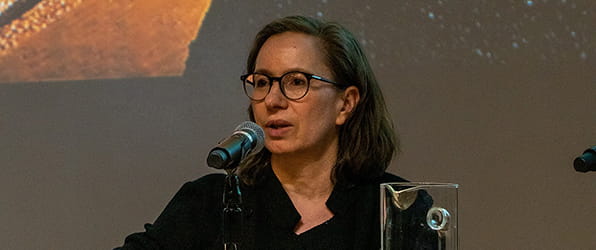
Andrea Fraser's passion for social justice and institutional critique was rooted in her childhood experiences growing up in what she calls a "lesbian feminist household that was half Puerto Rican."
Important Art by Andrea Fraser
Museum Highlights: A Gallery Talk
For this early performance, which remains one of her most famous works, Fraser posed as a museum docent named Jane Castleton at the Philadelphia Museum of Art, and guided a group of visitors on a tour through the museum. During the tour, she described the museum (including features of the building itself, like water fountains, the bathrooms, and the museum cafeteria) in an overly verbose, exaggerated manner. For instance, of the cafeteria, she said "This room represents the heyday of colonial art in Philadelphia on the eve of the Revolution, and must be regarded as one of the very finest of all American rooms." Meanwhile, she praised the water fountain for its "formal economy" and "monumentality". She also discussed funding and sponsorship at the institution, and sporadically shared her opinions on political and sociological ideas. At one point she juxtaposed quotations on the founding of America's great museums in the nineteenth century with passages about the appearance of poorhouses in the country around the same time. The script she used was based on several sources, including brochures from the museum's archives, art reviews, Immanuel Kant's Critique of Judgment (1790), Senator Daniel Patrick Moynihan's 1969 anthology of essays called On Understanding Poverty, and a 1987 article in The New York Times by Fran R. Schumer titled "Salad and Seurat: Sampling the Fare at Museums."
The work was borne of two major intellectual and artistic currents of the 1980s: Appropriation Art and psychoanalytic theory, which led Fraser to probe her own subject position in the art world. Fraser explained: "In the early '80s, everyone was appropriating images and text, so I thought about appropriating positions, functions, and roles. I was also very aware of how I was always performing. I was always trying to make people think I was older than I was, that I was more educated than I was, that I had more money than I had, that I was whiter than I was, that I was more legitimate than I was. When I started doing these museum tour performances, it was about being able to get on top of that, and being able to do that self-consciously."
Curator Leora Morinis describes the fictional Castleton, who wore a gray suit and white button-down shirt and had her hair pulled back, as "at once priggish and unhinged," her speech crescendoing "into, a kind of fevered pastiche." The disjunction between what museum-goers would normally consider mundane, such as the bathroom, and Castleton's excitement asks, "whether the pressures placed on art - the superlative claims and displaced desires - are similarly disproportionate," writes Morinis. Fraser's taking on of the role of the museum docent, furthermore, explores the power dynamic inherent in a museum setting, writes art historian Isabella Hill, in which the docent "has power over the audience, in having the knowledge of the museum or gallery setting and being able to control the narrative the audience is subject to."
As a work of institutional critique, Museums Highlights questions the very foundation of the modern museum: ideas about value and "pedagogy, aesthetic criteria, and systems of judgment," writes Morinis. In this way, the work challenges the concept of the museum as a "ritual site," as advanced by critic Carol Duncan in her influential text, Civilizing Rituals: Inside Public Art Museums (1995).
Performance - Philadelphia Museum of Art
Notes on the Margin
"This so-called piece of art is a deplorable, despicable display of vulgarity," begins a label in Fraser's Notes on the Margin, a work that took the form of seven museum/gallery wall texts that Fraser installed alongside some artworks inside an art museum. While museum wall texts typically provide basic information and sometimes an interpretive analysis in a neutral tone, Fraser's surprised visitors with their language, which was rendered all the more jarring by the clean, museum-style presentations. Much of her text was taken from statements made by American politicians, such as Senators Jesse Helms and Charles Grassley, who had pushed for increased censorship and reduced government funding for the National Endowment for the Arts earlier in 1989. Other texts in the series included definitive judgments such as, "This work is shocking, abhorrent and completely undeserving of any recognition whatsoever," and "He is not an artist, he is a jerk. [...] And he is taunting the American people."
In making art in the form of the wall label, writes art critic Jonathan Griffin, Fraser calls attention to the way in which "a museum exhibition is a powerful rhetorical device; gallery after gallery of judiciously selected aesthetic material beside didactic wall texts can make a particular hypothesis or observation seem indisputable, or a historical moment appear satisfyingly coherent." The work carries a two-fold meaning that reflects its time as well as the broader institutional framework of the museum. "On one level," writes Morinis, "the [quoted] commentary highlights very real attitudes and threats to creative freedom; on another, the labels turn back on themselves, pointing [...] to the fact that wall texts - impersonal and benign by design - can in practice be vehicles for strong, and potentially manipulative, opinion." And so, even as the art world fought back against politicians' attack on its creative freedom, the piece also reminds the viewer that the question of aesthetic judgment and historical value is never straightforward, even in the hands of arts professionals.
This series was later expanded into Fraser's 2013 series Take It or Leave It, included in the exhibition of the same name. Fraser's contribution to the show included fifteen wall texts installed alongside the works in the exhibition, which were by notable female artists like Martha Rosler, Adrian Piper, and Mary Kelly, as well as video of Fraser's own Museum Highlights: A Gallery Talk (1989).
1990 - Hammer Museum, Los Angeles, California
Kunst Muss Hängen (Art Must Hang)
This performance involved Fraser re-enacting, word-for-word and gesture-for-gesture, an impromptu speech drunkenly delivered by German artist Martin Kippenberger (1953-1997). Kippenberger had originally delivered it at the opening of an exhibition of works by his friend, Austrian artist Michael Würthle, at the Club an der Grenze in Minihof-Liebau, Austria, in 1995. The title of the piece, Art Must Hang, comes directly from a statement that Kippenberger made to Fraser, who knew him personally, before his death.
The original speech itself could be understood as a complex performance. Fraser provides an insightful analysis: "The speech," she reflects, "is full of what from an American perspective are misogynous, homophobic, and xenophobic elements. Now, it may be that misogyny, homophobia, and xenophobia were attributes of a certain position in the German art world and society that Kippenberger consciously took up and performed. It may also be that he was, in fact, misogynistic, homophobic, and xenophobic on some level. Maybe he knew that he was and maybe some of the self-loathing in his work sprang from such recognition."
Fraser does not speak or understand German, and it took her six weeks to memorize the speech. With her linguistic distance and impassioned re-enactment, Fraser doubled down on the ambivalence Kippenberger had displayed. Art historian Gregory Williams views this work as "both an homage to [Kippenberger] and a send-up of macho art world-posturing." Having incorporated her own ambivalence since her earlier work, the piece ups the ante with another layer: it seeks to caricature but also embody the ambivalence of an artist who, as a male German painter fitting in the European "bad boy" artist stereotype, occupies a vastly different subject position in the art world than she, an intellectual American woman artist, whose practice came out of engagement with critical theory and psychoanalysis.
Performance - Galerie Nagel Draxler, Cologne, Germany
Official Welcome
Fraser's performance for Official Welcome involved her assuming other roles/personas while delivering a welcome speech to a group of prominent collectors and founding members of the MICA Foundation. During the scripted performance, she rapidly flipped between sixteen distinct art-world personalities, who embodied particular archetypes, such as the presenter and recipient at art award ceremonies, the patron, the museum director, the curator, and the critic. "You know, it's fun to sell big artworks - and it's profitable. In the end, a good artist is a rich artist," she shouted as she moved cross the stage in imitation of a well-known dealer. "Most of the work we collect is about sex or excrement," she "chirp[ed] in the perky tone" that those in the know would've recognized as a prominent West Coast art collector. She recited paeans to artists who "propose utopian visions," "make space for radical criticality," and "create objects of unfathomable beauty." Channeling artists themselves, Fraser spoke in various voices, some with a put-on modesty if not a kind of indifference and others with pomposity or disdain for those who would honor them. When one character, a downtrodden postfeminist, stripped down to Gucci underwear and heels, her self-reflexivity and droll wit remained impressive: 'I'm not a person today; I'm an object in an artwork.[...] It's about emptiness.'" At this point, Fraser removed the undergarments and continued the speech fully naked. The speech included direct quotes from contemporary artists and critics, including art historian Benjamin Buchloh, Gabriel Orozco, Damien Hirst, Tracy Emin, and Kara Walker, as well as comments made by Bill and Hillary Clinton.
Curator Richard Martin notes that "Although Fraser does not explicitly inform the audience of the specific role she is inhabiting at any one time, the changes between different personae are signaled by distinct shifts in her tone, language and posture, often to comic effect." For Morinis, "Fraser makes visible the seams and pretense of these [art world] positions and the ubiquity of these types of speeches [...] revealing the self-congratulatory circuit of the art world." At the same time, in other moments the affective power of the quotations rest in what feels like "the genuine sentiments and vulnerable emotions of figures deeply invested in their work and the rituals intended to honor achievement." The piece holds together "clashing affects" from gratitude to cynicism.
According to Fraser, the piece is about "the profound ambivalence that's haunted so much twentieth-century art and particularly avant-garde traditions - the kind of love-hate relationship that artists have with art, its institutions, and the people who support them." She admits that "to some extent, this piece was driven by my sense of resentment and envy of my professional peers about whom all these great things were said." Probing art world psychologies and enacting them to the very same people within the circuit, the piece is "funny, brash, and often excruciating," writes Lescaze.
Video of performance - The Art Institute of Chicago
Untitled
Untitled (2003) is an hour-long, unedited, silent video recording, from a single camera mounted just below the ceiling, of a sexual encounter that Fraser had with an unidentified private collector in a room at the Royalton Hotel in New York. The collector had paid to participate in the creation of an artwork, not explicitly for sex. The sum paid has never been disclosed. Five copies of the video were made, three of which are in private collections, including that of the collector-participant.
The work scandalized the art world, and Fraser was attacked for "prostituting" herself. However, for the artist, the work was intended as a critique of the commoditization of art, and the way in which artists' sale of work to collectors could be viewed as a form of prostitution in itself. Lescaze notes that "The piece avoids pornographic clichés - there are no close-ups; it's as though the encounter had been secretly filmed by a security camera." Instead, Lescaze sees the work as closely related to similar pieces by earlier feminist artists, such as Carolee Schneemann's Fuses (1964-67), a film of the artist and her husband having sex shot from the perspective of their cat, as well as Martha Rosler's Vital Statistics of a Citizen, Simply Obtained (1977), which was comprised of footage of a male doctor measuring the dimensions of her naked hips and breasts. All three pieces share a concern with the portrayal and interpretation of a woman's body, especially when it comes to matters relating to sex and desire.
Lescaze explains further that Fraser's video is working through artists' experience in the contemporary art market, in which they are beholden to the whims of collectors, with their artworks, a product of their personal expression and creative labor, offered up for sale. It is, she writes, "a meditation on the experience of selling intimate parts of one's self." As for Fraser, she states that "For me, one of the clearest signs that 'Untitled' is a successful piece is that it didn't only upset people outside of the art world but a lot of people inside the art world as well," which meant that it pushed the boundaries of the art world's status quo. Part of the negative response, viewed this way, might have stemmed from the piece's confronting the art world with an unsavory image of their profession that many would rather not think about.
Fraser's piece can be viewed as part of a group of artworks created in the early 2000s that thematized and critiqued the transactional nature of the art world, such as the work of Santiago Sierra. They emerged from the context of the rapidly expanding and globalized capitalist art field then, with the rise of art fairs and biennials and wealthy collectors spending huge sums of money on speculative buys.
Video (color, silent) - Whitney Museum of American Art, New York
Open Plan: Andrea Fraser (Down the River)
When the Whitney launched its Open Plan series of rotating exhibitions, Andrea Fraser was given the first slot, in February 2016. The series gave artists free rein to create works and installations in the museum's dramatic, open-floor plan space on the fifth floor of its then recently opened new building. The sweeping and light-filled views of the Hudson River inspired Fraser to create Down the River, a sound installation whose title comes from a slang phrase used to describe convicted criminals sent "down the river" to the Sing Sing Correctional Facility in Ossining, New York. During Fraser's exhibition, visitors would come up to the fifth floor and find the space entirely empty. The only sensory engagement put in by the artist was a fifty-five-minute loop of audio recorded from Sing Sing's A Block. The piece aimed to transport art-goers, Fraser stated, "into the acoustic space of incarceration." She explained, "You're hearing doors and footsteps and a big, hard, cold, empty, confined and containing space. You feel the dehumanization of confinement through those sounds."
In developing this work, Fraser recognized a connection between museums and prisons, calling them "the bookend institutions of our increasingly polarized society - institutions that celebrate freedom, and institutions that revoke that freedom." Since the 1970s, as Lescaze notes, the number of museums as well as prisons in the United States has tripled. Fraser views them as "really two sides of the coin of social inequality." She explains: "Museums increasingly are warehouses of wealth, capturing surplus in the form of artworks that are no longer financially productive. Prisons are institutions that warehouse surplus labor and populations that have been economically excluded from the labor market." In this way the work echoes one of her earliest performances: Museum Highlights, with its juxtaposition of American museum and poorhouse histories.
The piece's effectiveness has been questioned by others. Curator and archivist Nicole Kaack found that, while conceptually strong, Fraser's piece may not have had the desired impact on the viewer, despite its lengthy informative wall text. And, conceptual artist and writer Chloë Bass reported that when she visited the installation, "I saw kids running, adults taking in the view of the river, couples flirting, even people walking backwards just to feel the magnitude of the space," but it remained unclear as to whether museum-goers were actually "following the piece." One museum docent informed her that many visitors thought the sound was actually just the amplified noise from other floors of the museum. Bass questions whether the piece is "part of the current epidemic of guilt porn," that is, weak attempts by art institutions to be transparent and to engage in self-critique.
It should be noted, however, that much of the meaning of Down the River also developed through the discourse surrounding the work. Beyond the audio recordings, Fraser used media interviews and public seminars to bring up relevant social and political issues, such as the possibility "that arts institutions, as they grow and expand, are actually draining social services organizations" and the fact that "there are more African Americans in prison today than were enslaved in the entire history of slavery." Fraser stated that she wanted to foster "reflection on and recognition of" the reality that immense wealth, power, and privilege (represented by the museum space itself, as well as the new condominium developments and high-end real estate visible along the shores of the Hudson) exist alongside spaces rife with "extreme poverty, mass incarceration, and racial and class divisions."
Sound Installation - Whitney Museum of American Art, New York, New York
Biography of Andrea Fraser
Childhood
Andrea Fraser's passion for social justice and institutional critique was rooted in her childhood experiences growing up in what she calls a "lesbian feminist household that was half Puerto Rican."
In Berkeley, Fraser explains that she and her family "became hippies very quickly." Her mother became a lesbian and got involved in the women's movement. "My brothers, I think, were selling drugs when they were 10, 11? We were all pretty precocious." Fraser remembers making banners for gay pride marches in her mother's kitchen. She grew up reading poems by the influential lesbian poet and essayist Adrienne Rich and perusing publications such Our Bodies, Ourselves (first published in 1970), a groundbreaking text that foregrounded issues of women's health and sexuality.
Despite Berkeley's liberal atmosphere, however, her mother struggled with becoming an artist in the white male-dominated art world of the United States at the time. According to Fraser, her mother "stopped painting when I was about three because she got one too many racist, sexist rejections, and then she turned to doing performances and to writing." As a child, Fraser said that she also internalized the "pain of exclusion." The experience would shape her ambivalence toward the art world when she herself became an artist.
Fraser recalls that her first museum experience was at the Exploratorium, a science museum in San Francisco, where she enjoyed the interactive exhibits. She reflects, "I think that probably influenced my sense of the most valuable thing to me about museums, which is the opportunity for experiential learning in an embodied way, in a space about culture, identity, and social interactions".
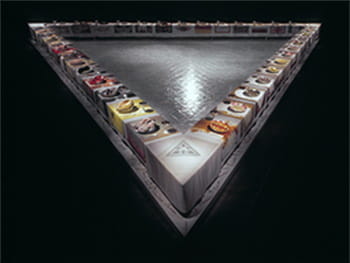
Her first memory of visiting an art museum was at an exhibition of "hard-edge minimalist painting" at the SFMOMA. She recalls, "I was reading the wall labels, and I was running around from label to label, saying, 'Mommy, Mommy, all these paintings have the same name! It's Unifield.' But it was Untitled." Years later, she would develop two series of artworks that took the form of museum/gallery exhibition labels. She also has memories of skipping school at the age of thirteen to take the bus to San Francisco to see Judy Chicago's The Dinner Party (1974-79), a key feminist artwork, which showcased the contributions of women to society in history.
With her mother's support, Fraser dropped out of high school at the age of fifteen, and shortly thereafter moved to New York. When she first arrived she would visit the Metropolitan Museum of Art about four times per week, spending the entire day there. She says, "I was encountering this powerful, normative, legitimate, elite culture that I wanted something from, but that I also felt crushed, alienated, and dominated by. [...] That love/hate relationship to art museums and to what they represent is really what defined the course I took as an artist with institutional critique."
Education and Early Training
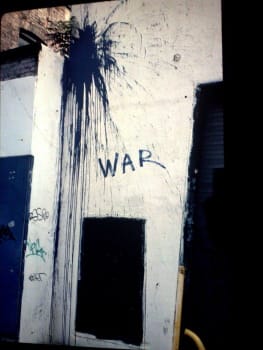
In 1982, at seventeen, Fraser began studying at New York's School of Visual Arts, where she stayed until 1984. She then entered the Independent Study Program at the Whitney Museum of American Art. The program was a hotbed of critical theory, psychoanalysis, and postmodernism. There Fraser studied with feminist artist Barbara Kruger, who praised her "incredibly brilliant mind." The following year she enrolled in New York University. Some of her most influential teachers included leftist art historian Benjamin Buchloh and post-modernist art critic, gay activist, and feminist theorist Craig Owens.
In New York, Fraser developed a close circle of artistic friends that included writer, artist, and activist Gregg Bordowitz, writer, art historian, and critic Joshua Decter, conceptual artist Mark Dion, and artist and photographer Collier Schorr. She dated Bordowitz for a time. He later remarked that "Andrea was scary brilliant. Frighteningly brilliant, very intimidating. And at the same time, very fragile, because I think she even scared herself sometimes with what she saw and understood about the art world and its terrible contradictions."
Reflecting on her artistic formation in the 1980s, Fraser said, "[It] was an 'end of everything' decade. It was the end of painting, the end of the avant-garde, the end of modernism. Everything was ending. I think one of the challenges was: What parts of those avant-garde traditions against the institution can be carried forward, and what parts of those were just myths? What parts of them were just narcissism? I did absorb that there was a potential for internal critique that had been established by avant-garde traditions. But there was also this component of rejecting an aspect of avant-garde narratives that are rooted in the Oedipus complex of the boy - that we have to overthrow our predecessors."
It was during these years that Fraser and her friends developed the concept of institutional critique. The term refers to artists and artworks that are critical of galleries, museums. and other institutions, calling attention to how they are run, where their funding comes from, and how they impose restrictions or limitations on artists. In the mid-late 1980s, Fraser developed artworks that grappled with the aura of high art, such as an artist book that appropriated images from art history. She engaged with performance, creating a breakthrough piece Museum Highlights: A Gallery Talk in 1989. In the piece, she performed as a museum docent and satirized the language and protocol of veneration in art museums. She also wrote art criticism and would continue writing and research as part of her artistic practice throughout her career. In 1990, she held her first solo show at the Galerie Nagel Draxler in Cologne, Germany.
Mature Period
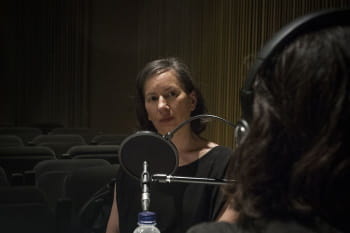
In the late 1990s, when museums and the art world in general were becoming increasingly corporatized, Fraser felt a sense of "crisis" regarding her work, particularly as she found the idea of institutional critique to have become more problematic, as artists engaged with institutional critique more and more became embedded within the system they sought to critique. She explains that she was also "fed up with the art world, [..] fed up with being poor and being broke and being in debt and struggling to live in my own apartment in New York."
Fraser was considering leaving the art world altogether to pursue a PhD in anthropology when she received a tenured teaching position at the University of California, Los Angeles (UCLA), which alleviated her financial stress. She is currently the Department Head and Professor of Interdisciplinary Studio of the UCLA School of Arts and Architecture.
In addition to UCLA, Fraser has taught at numerous other art programs in the United States. Reflecting on her teaching practice today, Fraser notes, "I do sense a shift away from the traditions that defined my approach to things, which came from European Marxist thinking. It was colonial, and it was white, and it was partially male. What I'm seeing among the younger generations of artists now is a radical turn [...] toward a politics and ethos of inclusion, of affirmation and radical care that is coming out of queer feminist, Black feminist, and disability and decolonial theory. And I think it is very powerful, and I feel very challenged by it."
Fraser is currently based out of New York and Los Angeles. She lives with her husband, Andy Stewart, and their toy poodles Winnicott and Bowlby. She serves on a number of museum boards and councils and is often called upon to provide guidance to museum professionals on matters relating to ethics and challenges facing art institutions today (many of her art world friends with a similar equity and social justice vision are now, like her, in positions of power). She sees her role in this regard as a continuation of institutional critique, but as a veteran making changes from within.
The Legacy of Andrea Fraser
Through both her artistic practice and writing, Fraser explores a wide range of issues related to institutional critique. Not only does she investigate arts institutions and their inner workings, but she also expands her critique to other forms of institutions, such as prisons and slavery, and the less-tangible institution of racism as historically built into the social and political fabric of the nation. Exposing the interconnectedness of such institutions with the art world, she carries on the work of earlier pioneers of institutional critique, such as conceptual artists Hans Haacke and Daniel Buren, as well as artists and scholars working in the fields of feminism, psychoanalysis, and sociology, especially the French sociologist Pierre Bourdieu, who explored class strata and the art world in his academic scholarship. Fraser's approach is known for being "biting and often very funny," writes curator Leora Morinis. The use of acerbic humor combined with her trenchant critique has allowed Fraser's body of work to stand out among her theory-driven peers as an example of an accessible and impactful translation of theory into art.
But perhaps Fraser's biggest contribution to the discourse of conceptual art and institutional critique is her use of her own body as a medium, which brought into the discourse the vital power and vulnerability of Performance art as well as issues of gender and sexuality. Unlike her male predecessors, Fraser, with her interest in psychoanalysis, also openly acknowledges her own stakes, whether "emotional, economic or otherwise," in the art world. "Fraser made herself the site of her art," writes art historian and curator Zoë Lescaze, "and explored her own fragility in the process, effectively redefining the genre." Curator Scott Rothkopf concurs: "one of the things that makes her work so important is that the clarity and the depth and the rigor of her thought is matched by tremendous emotional breadth." Her work's affective power opens up a connection with viewers through a "radical empathy," writes curator Connie Butler, who sees this as her "great innovation." In these ways, Fraser has influenced a younger generation of artists, especially those concerned with contemporary institutional critique and feminism, such as performance artist Emma Sulkowicz, who cites the way Fraser "mocked the masculinity of the museum space" as an inspiration for her work.
Influences and Connections

-
![Hans Haacke]() Hans Haacke
Hans Haacke -
![Daniel Buren]() Daniel Buren
Daniel Buren -
![Sol LeWitt]() Sol LeWitt
Sol LeWitt -
![Louise Lawler]() Louise Lawler
Louise Lawler - Michael Asher
- Gregg Bordowitz
- Joshua Decter
- Mark Dion
- Collier Schorr
- Tom Burr
- Emma Sulkowicz
- Damiano Dentice
- Ellen Formby
- Gregg Bordowitz
- Joshua Decter
- Mark Dion
- Collier Schorr
- Tom Burr
Useful Resources on Andrea Fraser
- Andrea Fraser: Collected Interviews, 1990-2018Our PickBy Rhea Anastas and Alejandro Cesarco
- Andrea FraserBy Sabine Breitwieser, Shannon Jackson, and Sven Lütticken
- Andrea FraserBy Yilmaz Dziewior and George Baker
- Andrea Fraser: Texts, Scripts, TranscriptsBy Carla Cugini
- Institutional Critique and AfterBy John C. Welchman
- Institutional Critique: An Anthology of Artists' WritingsOur PickBy Alexander Alberro and Blake Stimson
 Ask The Art Story AI
Ask The Art Story AI